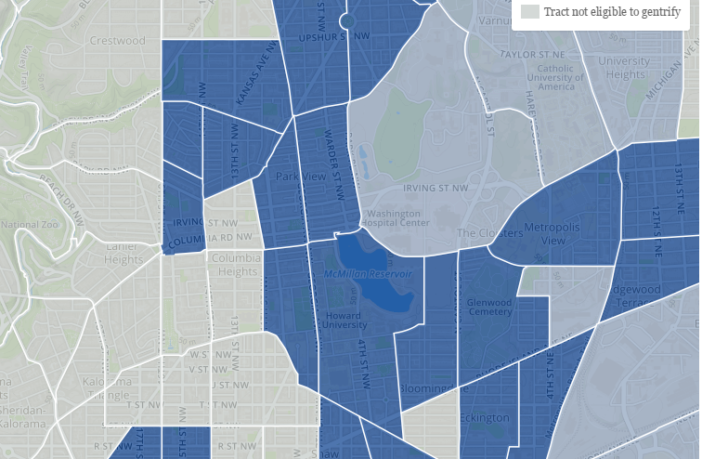
A few days ago, a series of reports came out about gentrification in the US that got a lot of press coverage: Governing magazine attempted to look at data to show where gentrification was happening and where it was highest. According to their analysis, DC was the second-most gentrifying city in the country, behind Portland, Oregon, and much of our area was considered to be gentrifying.
The G-Word is a big draw for articles and comments, and lots of places (like the Post) picked up on the article, adding some details but mostly summarizing the original report. Interestingly, the analysis uses a photo of 14th Street in Columbia Heights as its main photo — the poster child, if it were.
For the article (and accompanying interactive maps), Governing defines gentrification using Census data, comparing 2000 to 2009-2013: tracts that were in the bottom 40% of median home value and median income in their metro area were “eligible” to gentrify, and were considered gentrified when median home values increased and the increase in the inflation-adjusted median home values and in percentage of adults with bachelors degrees were in the top third of their metro area. That is, places with low home values and low incomes that then had higher home values and big increases in home values and the number of college grads were considered to have been gentrified.
Confusing? Yeah, it is. Why is it lowest 40% and then highest third? I dunno. And why compare static values to a subset of changes in values, and then toss in a new variable, increase in college grads? It just seems like there could be a lot going on here that could be explained by other factors. Maybe more college students are moving to cities than they were in the past — does that mean gentrification is occurring there?
To their credit, Governing includes their methodology, but doesn’t talk a lot about why they chose what they chose: why not include race, for example, or more about education? As part of their explanation, they said this, though without quoting any research that supports their conclusions.
Some research examining gentrification has instead focused primarily on changes in household income. However, many of the first residents to “gentrify” a neighborhood are often artisans or young professionals who might not earn much more than their new neighbors. Such changes to a community are not reflected in income levels. For this reason, Governing instead measured changes in educational attainment, which strongly correlates with income.
The racial makeup of a neighborhood was not a condition for gentrification to occur. Gentrifying Census tracts were, though, found to experience increases in the concentration of non-Hispanic white residents.
But is that true? Are artists and bohemians who don’t have any more money than the people who already live there actually gentrifiers, or the precursors to gentrifiers? What is gentrification, anyway? And if education correlates with income, why even use it?
And then, as the City Commentary blog points out, Governing makes it more confusing with another article in the same series, which asks what gentrification is but doesn’t really answer it. The answer seems to be their formula.
It’s actually one of the many reasons why I try not to use the term “gentrification” on this blog, just like I try not to use the term “hipster,” as they mean many things to many people. Does gentrification mean more wealthy people? Does it mean more college grads? More “millenials”? More white people? Fewer minorities? Displacement of poorer residents? Some of these? All of these?
As City Commentary points out, many of these supposedly gentrifying census tracts reported increases in poor residents as well as wealthier ones, so poor people may not actually be displaced.
And there are certainly many new and expensive condos and apartments in our area, which results in increasing average house prices — but are those new expensive places resulting in higher rents in lower-income homes? Are people in the cheaper houses being forced to leave? Or is it just that that more expensive units = higher average cost and not a zero-sum calculation? I don’t know. Many of these big condo buildings went up on empty lots, like those around 14th and Florida and Georgia and New Hampshire, but at the same time, we hear about townhouses being broken into multiple fancy condos. Another article in the series talks about increasing housing prices and rent control, but only in average terms.
It’s confusing. Is Columbia Heights gentrifying? According to Governing, yes, it is — their maps show most census tracts in our area, especially along Georgia Avenue, as gentrifying. I think most people would agree. But I think many people would disagree on what that means, or at least lack the data to prove it. What do you think?




